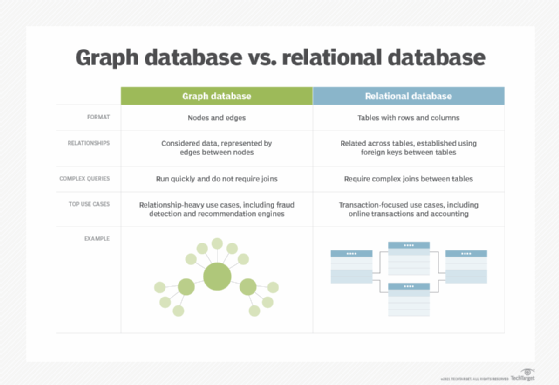
Getty Images
Graph database vs. relational database: Key differences
Graph databases offer plenty of advantages for enterprises, but relational databases still top the market. Both emphasize relationships between data, but how do they compare?
Relational databases are a staple across industries, but graph databases offer different capabilities that may fit enterprise needs better.
Graph databases are one of four popular NoSQL database types that organizations can consider using instead of relational databases, and their usage continues to grow. The other types include column-oriented, document and key-value store databases.
It's important to know the differences between a graph database and a relational database to understand how each fits in a rapidly evolving technology landscape. Each offers different advantages in terms of data models and ability to connect relationships between data.
What is a graph database?
A graph database is a NoSQL database that stores data as a network graph. Graph databases are different from the other NoSQL options in that they document and prioritize the relationships between data. They can work in concert with knowledge graphs to uncover deeper insights into the relationships.
Graph databases are made up of nodes and edges, where nodes represent specific entities, while edges represent the connection between two nodes. They are designed to be scalable and offer flexibility that's hard to find in other databases.
Advantages of a graph database
- Relationship mapping. Graph databases excel at mapping the relationship between data points, such as social networks, fraud detection or computer networks. Users can easily create nodes and track the relationships between them. They're visually easy to digest and draw insights from.
- Flexibility. Graph databases don't use a rigid structure. Users can create and connect nodes as needed, making it a great choice for complex data sets with many connections.
- Performance. Graph databases can use each node as an index for related nodes. They can identify and find linked data quickly, and their query speed doesn't decline as the database size expands.
- Scalability. Graph databases are great at handling growing data sets because of how easy it is to add more nodes to a graph database. Graph databases can also split into groups of smaller, closely related data points and be stored on different servers without any major effects on performance.
What is a relational database?
A relational database stores data in relational tables. Columns and rows define each table. A unique key identifies each row so it can link to rows in other tables.
Each individual table also includes a primary key identifying the information found within the table. For example, one table may contain customer information that relates to information in a different table containing order information.
Relational databases separate the logical structures of tables and indexes from physical storage structures. Data professionals can make changes to the physical data structure that don't affect the logical structure.
Advantages of a relational database
- Accuracy. Relational databases only store data once, eliminating deduplication concerns.
- Ease of use. SQL makes complex queries easy for users, regardless of technical skill.
- Collaboration. Multiple people can use the database at the same time. A user can lock the database to prevent any changes when updating data.
- Security. Assign different levels of permissions to users to easily manage who has access to what data.
- Data categorization. It's easy to categorize, store, query and filter data. After constructing the database, administrators can add new categories without modifying existing ones.
Key differences of graph databases vs. relational databases
The most notable difference between the two is that graph databases store the relationships between data as data. Relational databases infer a focus on relationships between data but in a different way. The relational focus is between the columns of data tables, not data points, and the different approaches offer different benefits.
Storage and scalability
Both databases make adding new data easy. The flexibility of a graph database enables the ability to add new nodes and relationships between nodes, making it reliable for real-time data. Graph databases grow horizontally and can partition a large graph into smaller graphs.
Relational databases scale vertically. Data teams can add new tables and columns while the database is running. Additions have a limit as relational databases require more storage space and processing power to maintain performance as they expand, which can incur additional costs.
Relational databases can scale horizontally using sharding, which splits the data across multiple physical servers. Partitioning typically stores all the data in a single server.
Performance
Complex queries typically run faster in graph databases than they do in relational databases. Graph databases use index-free adjacency to quickly move between nodes. The database uses the relationships between data points to guide it to other related entities. Partitioning the database into smaller graphs groups related data closer together so the database can quickly identify the data it needs without scanning the entire database.
Relational databases can identify relationships between data tables, but it must scan each table individually. The process of performing complex joins on data tables to perform complex queries is not as fast as a graph database.

When to use a graph database or relational database
Both types of databases offer advantages to users. Deciding between graph database vs. relational database adoption depends on the use.
A relational database excels in situations where the organization requires structured data that has strong integrity and consistency:
- Tabular structure works well for records with uncomplicated relationships, such as finance transactions or resource management.
- Straightforward data with established relationships, such as accounting and other transactional data, fits easily into the relational database format.
Graph databases' added emphasis on relationships helps explore complex data sets. Data professionals can find unexpected connections between data points, making them a top choice for relationship-heavy uses:
- Graph flexibility enables modifications to part of the database without affecting the rest of the data, accommodating data that constantly or rapidly changes.
- Common uses for graph databases include social networking, fraud detection and recommendation engines.
- Mapping relationships makes graph databases a good fit for data visualizations.
Organizations may also benefit from using both types of databases. Graph databases and relational databases prioritize connections, but the structure of the relationships gives advantages or disadvantages for different applications. Choosing between a graph database vs. relational database comes down to evaluating what each application needs.
Kara E. Joyce is a former site editor at TechTarget.







